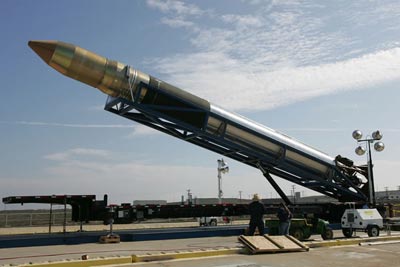Spaceflight needs a reality checkby Eric R. Hedman
|
| I personally don’t know how SpaceX can say they have developed a family of reliable launch vehicles when no models have even flown. |
The complaint is contending that the proposed United Launch Alliance merging the EELV operations of the two companies violates the Sherman Antitrust Act and other laws depriving SpaceX of the opportunity to compete with their lower cost, more reliable vehicles. The complaint goes on to say that the agreement between Boeing and Lockheed buries the details that would have come out about the unethical way Boeing obtained Lockheed secrets in the initial competition for launches. What the complaint doesn’t mention is why the Air Force wanted to fund the development of two modern families of launch vehicles and what the projected commercial launches was at the time of the initial contract awards. The US military gets more dependent on space-based assets every year. It needs extremely reliable ways to orbit and replace these assets. It needs those capabilities to be US-based for obvious reasons. After the Challenger accident, the lesson sunk in that the Air Force could not be crippled by the grounding of one vehicle. If a fundamental flaw is found in either the Delta or Atlas family, it would have the other to maintain access to space.
In 1998, when the contracts to develop the two lines of EELVs were let, the market for commercial launches was nearly three times the size it is today and was expected to grow. It was expected that commercial launches would help keep both EELV lines viable. It was before the telecom collapse and significant technology changes that hurt the market. More and more long distance and international phone calls are carried on a rapidly growing network of cheap fiber optic lines. The reduction in communications satellite launches has not been made up with launches of satellite TV and satellite radio cargoes.
I’m not so convinced that the ULA merger is preventing is preventing SpaceX from getting the chance to compete for government contracts. If I was in charge of contracting launches for the Air Force, I would be very reluctant to award a contract to SpaceX until they had a number of successful launches under their belt. You just have to look at what happened to ESA’s CryoSat when they selected Russia’s Rockot launch vehicle. The €140-million Cryosat is swimming in Arctic ice instead of measuring it. Russia has vast experience launching satellites, compared to none as of yet at SpaceX. If I’m launching a half-billion-dollar NRO payload, I would look more to proven reliability than saving possibly fifty million on a launch.
| If new launch vehicle companies are to survive, there needs to be a thriving commercial market. |
I have no expertise in antitrust or racketeering laws. I have no inside knowledge of the deal making between the Air Force and Boeing and Lockheed. Given that, I don’t have any guess as if the court system will find merit with SpaceX’s suit. Nor do I have any insight as to the probable outcome of the legal action. I just think the whole satellite launch market is not looking up any time soon.
According to Kistler Aerospace’s web site, their financial backers have reduced their funding until the market opportunities become clear. They say that they are the only viable option for resupply of the ISS. They seem to be waiting for NASA to decide to give them a contract to do so. Supplying the ISS may be the only viable option for Kistler to survive. With the Congress lifting the INA restrictions on buying crew and cargo delivery from Russia, even that option might be gone.
In a down launch market large companies have greater resources to keep their launch businesses alive. Key employees can be transferred to other divisions preserving a talent pool until the market returns. If new launch vehicle companies are to survive, there needs to be a thriving commercial market. It’s possible that even the market for TV and radio broadcast satellite launches could vanish. SBC and other companies are experimenting with ways to speed up broadband and deliver TV over IP. With the growth of Wi-Fi, satellite TV and radio may find additional competition delivering content over both wireless and wired IP-based networks.
In consumer electronics there is a price point where a market takes off. If a device gets below $500 it has a much better, but not guaranteed, chance to succeed and grow explosively. In the space launch business there are two main parts to the high cost. One is the launch vehicle. The other is the payload. If the launch vehicle cost is reduced from fifty to ten million dollars and the payload stays at one hundred million the overall mission cost has only dropped from one hundred fifty million to one hundred ten million. The payload cost needs to drop significantly before mission costs get below the price point where the market takes off. I doubt if most people agree where that price point is.
For now a greater share of the launch market is for government payloads. And at the moment there are few growth opportunities there. I think, then, this is the reality SpaceX and Kistler Aerospace are running into. I could be wrong, but I think the chances of success for companies in this market have significantly diminished.
